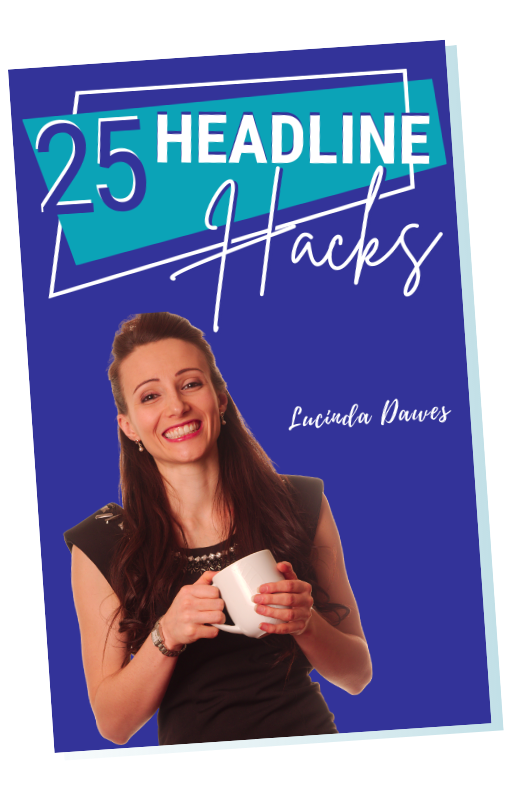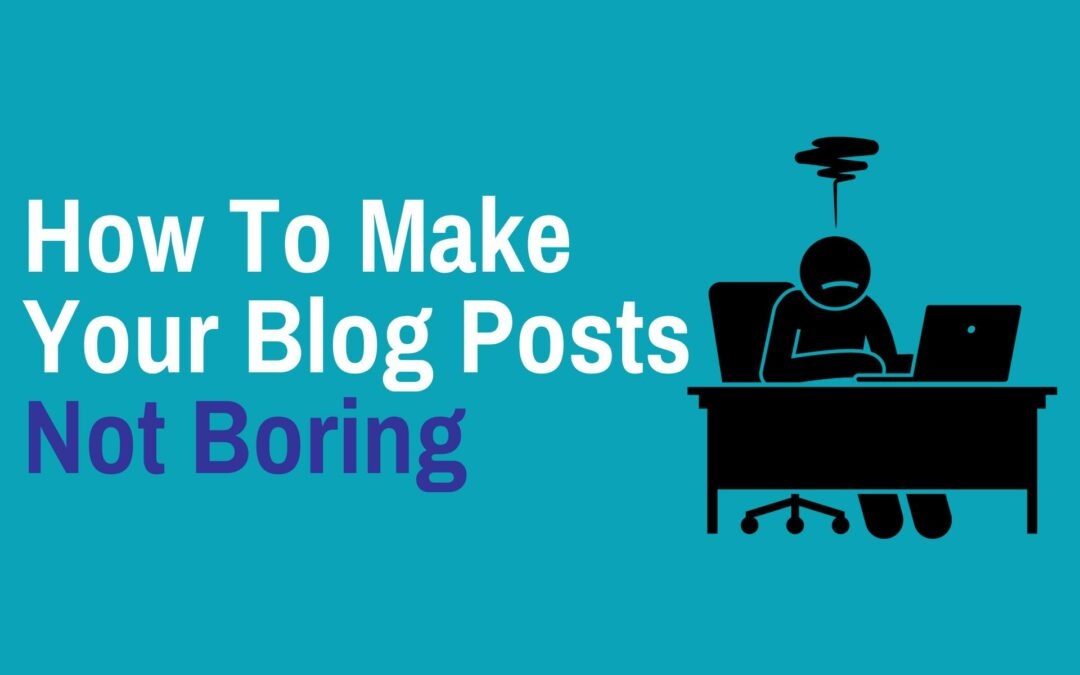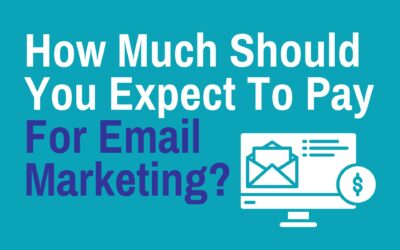There’s no shortage of crappy content out there.
The internet is jam-packed with blog posts on every topic you can think of from time management tips and parenting advice, to the more unusual topics like 10 household items you can use as a sex toy.
Yup! That’s a real thing. I just found it on my hunt for “weird and wacky blog posts”. Honest.
There’s a lot of competition online.
But most of the content out there is just bloody boring.
I can’t even count the hours I’ve spent skim-scrolling through blog posts that promised something great but delivered nothing more than the same re-hashed info in a dull, ‘poke-me-in-the-eye-boring’ way.
This is great news!
It means people are desperate to read something that’s exciting, interesting and actually gives some fresh, valuable content.
Enter… you.
I know you already know the benefits of blogging.
You already know that posting regular blog content will increase your search ranking on Google, increase your social media engagement, build a better relationship with your customers, position you as an expert and help you make more sales. AKA make you more money.
But how do you make sure your blog content isn’t just as bland as the rest?
That’s easy.
1: Pick Topics That Are Actually Worth Reading About
I’ll hold my hands up here and say this is something I’ve fallen foul of myself in the past too. I’m a pretty skilled writer (and modest too). So I can quite literally make a blog post out of anything.
But just because you can write about something, doesn’t mean you should.
In my Content Writing Crash course, one of the exercises I give my students is to write a blog post about the last time they went to a cafe for a coffee. Boring as hell right?
The idea is to push them to look at things from different angles, learn how to deliver key messages through storytelling and develop their ability to make even the most mundane of stories interesting.
It’s a great exercise and some of them produce some good posts. But just because we can make a blog post out of a trip to a coffee shop, doesn’t mean we should.
Before you write your next blog post, ask yourself if it meets the ‘RIOT’ criteria.
R- Relevant: Is this topic useful to your target market? Is it relevant to them and the problems they’re currently facing?
I- Impactful: Will this topic make an impact on your reader? Will it give them something of value in exchange for their time reading?
O- Overdone: Is this topic interesting and can you write it with a fresh new perspective, not just a re-hash of what’s out there already?
T – Talkaboutable: Is this topic worth sharing? Is it something people will tell their friends about or share on their social media?
If your topic hits the ‘RIOT’ criteria then you’re onto a winner.
2: Be Yourself
Don’t worry, I’m not going all ‘heart-centred’ on you.
I’m not going to start preaching about how you need to find your third eye and operate your business from your root chakra. I seriously hate all that. My hippy traits are confined to my medicine cupboard. And maybe my yoga practice. And tattoos.
Business I prefer to do a little more directly.
When I say be yourself, I mean be real.
Use the language you’d use in conversation, say the things you’d say in real life and allow your personality to come through in your writing.
People like to get to know people.
If you share your story while educating, entertaining and solving your reader’s problems then they’ll get to know you, like you and trust you.
Take this post as an example. This is a post teaching you how to write interesting content. But you’ve also learnt lots about me.
You know that I hate the hippy-fluffy approach that lots of women take towards business. You know that I like natural medicines, that I practice yoga and that I have tattoos that you’ll (most likely) never see.
You’re probably also starting to realise that I’m pretty direct and I like to push the boundaries of what’s acceptable to mention in a business-related post – like DIY sex toys.
But it’s all real. It’s all me. I am that blunt in real life. I do have a dry, witty sense of humour and I’m more than happy to crack a few inappropriate jokes if it breaks the ice.
If you meet me in real life after reading my blog posts you’ll already feel like you know me. Like like we already have a relationship.
That’s how you get results from your content and keep your reader’s reading…
But how do you do that?
How do you stop the ‘professional’ writing robot taking over and word-vomiting boring content that’s devoid of any of your actual personality all over your page?
Partly, it’s practice. But mostly it’s having a clear understanding of who you, your company and your customers are, and what you stand for.
It’s by understanding your story strategy.
If you’ve not got your story strategy figured out just yet, I can help. But in the meantime, you can de-robot your writing by recording yourself reading it out loud. Listen to it, and if it doesn’t sound like you in normal conversation then go back and edit until it does.
3: Tell Stories
Last week my 15-year-old and I had a little chat. Now, he’s way better behaved than I was at his age. He doesn’t drink or smoke or hang out on the streets. He has nice friends and nice hobbies. He’s just a great kid.
But he’s headstrong and won’t be told what to do. (I have no idea where he gets that from…)
Now, we all want to protect our kids and keep them safe. But teenagers (even the good ones) like to rebel. It’s kind of their thing.
I know that telling a teenager not to do something is more like an invitation for them to try rather than an effective warning not to do it.
So I came up with a way to tell him not to do stupid things, without directly telling him not to do stupid things.
I tell him stories.
I like to think of it as undercover parenting. Teaching him important things without him knowing it’s happening… I hope he never reads this post or my cover will be blown!
I tell him stories about other people who have done stupid things and the consequences that they’ve had to deal with as a result.
Like when I was a teenager and got into a car with two lads that I’d never met before. It seemed like a good idea at the time. But when they drove me back to their house, started watching porn, drinking beer and snorting cocaine before driving me back home I realised what a terrible plan it had been. Now, as an adult, I can see just how lucky I was. That situation could have been so much worse!
So I don’t tell my boy not to get in stranger’s cars.
Instead, I tell him this tale and we laugh together at my stupidity, discuss all the ways it could have gone terribly wrong and our conversations end with me saying “You’d never do something as stupid as that would you?” and him looking at me with that look of parental disappointment and disgust that only a teenager can muster and replying “Don’t be ridiculous”.
It’s the perfect example of the power of stories.
Stories are one of the most powerful tools in marketing. As you’ve seen here, stories can be used to deliver messages that may otherwise be resisted.
They can subtly educate, inspire and overcome objections… All without the reader even knowing it’s happening.
And they can make even the most boring of topics interesting and engaging.
Look at this example here – I’ve just told you a story about how I use stories to teach my son not to do stupid shit, whilst also teaching you how to use stories to make your topics interesting.
I could have just said “Tell stories. People like to read them more than they like to read boring stuff” but that wouldn’t have been quite as interesting now would it?
So there you have it.
Three ways to make sure your blog posts are not as boring as the rest.
If you’ve found this blog post useful then share your comments with me and the link with your friends 🙂
FREE
25 HEADLINE HACKS
Struggling to come up with an attention-grabbing headline?
Fill in the form below to access my 25 Headline Hacks and start writing killer headlines that will piques your readers interest.

If you liked this post, then you’ll like these too…
How to Write Emails That Sell More Stuff
What are you doing to sell your services or products? You have a shiny, modern website, right? It has an up-to-date shop with a great user experience? And you have regular blogs going up that are engaging and filled with SEO? That’s great. What about emails? I saw you...
How Much Should You Expect To Pay For Email Marketing?
Everyone likes a low-cost, high-return purchase. And that’s why marketing consultants are quick to sell you on the multitude of benefits of email marketing! It’s short, requires very little technical knowledge to get set up and can improve your customer retention like...
Inbound Marketing Vs Outbound Marketing – The Pros & Cons Of Both
Let’s be honest - the ‘Skip Ad’ button is one of the best things since sliced bread. Over time, marketers have learned that people don’t always like to be interrupted. Sometimes, you just want to watch your damn video! That’s how the ‘inbound marketing vs outbound...





